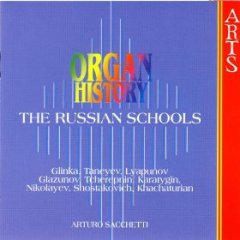Arturo Sacchetti - Organ history: The Russian Schools (1997)
Arturo Sacchetti - Organ history: The Russian Schools (1997)

1 Fugue (Glinka) 2:19 2 Choral Variée (Taneyev) 6:44 3 Prélude Pastorale, Op. 54 (Lyapunov) 13:37 4 Fantaisie, Op.110 (Glazunov) 19:59 5 Chérubique (Tcherepnin) 5:47 6 Prélude Et Fugue À La Russe (Karatygin) 9:11 7 Fugue (Nikolayev) 4:31 8 Introduction Et Fugue (Khachaturian) 6:16 9 Passacaglia, Op. 29, From "Katerina Izmaylova" (Shostakovich) 8:01 Arturo Sacchetti - Organ
Arturo Sacchetti's Organ History recordings for the Arts label offer a broad survey of music from many countries, and this installment covers nineteenth- and twentieth-century works from Russia. Since Russia is the least likely of the nations represented to have produced any original organ literature -- due to the instrument's exclusion from Orthodox churches and relegation to the concert hall -- it is therefore not surprising that most of this music is heavily derivative of German and French styles, and almost exclusively secular in nature. While a few of these pieces show the industriousness of their composers, such as Lyapunov's intricate Pastoral Prelude and Glazunov's ambitious Fantaisie, Op. 110, there is nonetheless an academic stodginess in this music that only occasionally allows for brilliance. Also noteworthy, though not exceptional, are Glinka's tidy Fugue, Tcherepnin's atmospheric Chant chérubique, and Shostakovich's odd Passacaglia from Katerina Izmaylova. Each offers a perspective on the organ's place in Russian musical life, yet all reflect the restrictive attitudes of the times when they were written. Showcasing four different organs in Rome, Italy, and recorded from 1985 to 1991, this album fulfills its obligation to the series by presenting its obscure subject well, though Russian organ music remains a byway of limited interest and appeal. --- Blair Sanderson, Rovi
This CD is an important contribution to this series of CDs on different national schools of organ music. We associate composers like Glinka, Taneyev, Lyapunov, Glazunov, Khachaturian and Shostakovich with orchestral music and not with organ music. So it is very interesting to hear what these composers did when composing for the organ. A second aspect of the CD (as with the others in the series) is that the works are in chronological order of birthdates of the composers, so one can hear how the styles have changed over a period of more than a hundred years. Thirdly, the recordings were not all made on the same organ, and it is interesting to hear the different organ sounds. Fourthly, it comes at a reasonable price. Having said all that, this is really an esoteric CD for musicologists and fundis of the organ. There is not much that will readily appeal to the lay listener, not much of a 'Wow! Listen to that!' response. Bear that in mind before you order. ---Gerhard Griesel, amazon.com
download (mp3 @320 kbs):
yandex 4shared mega mediafire zalivalka cloudmailru uplea








